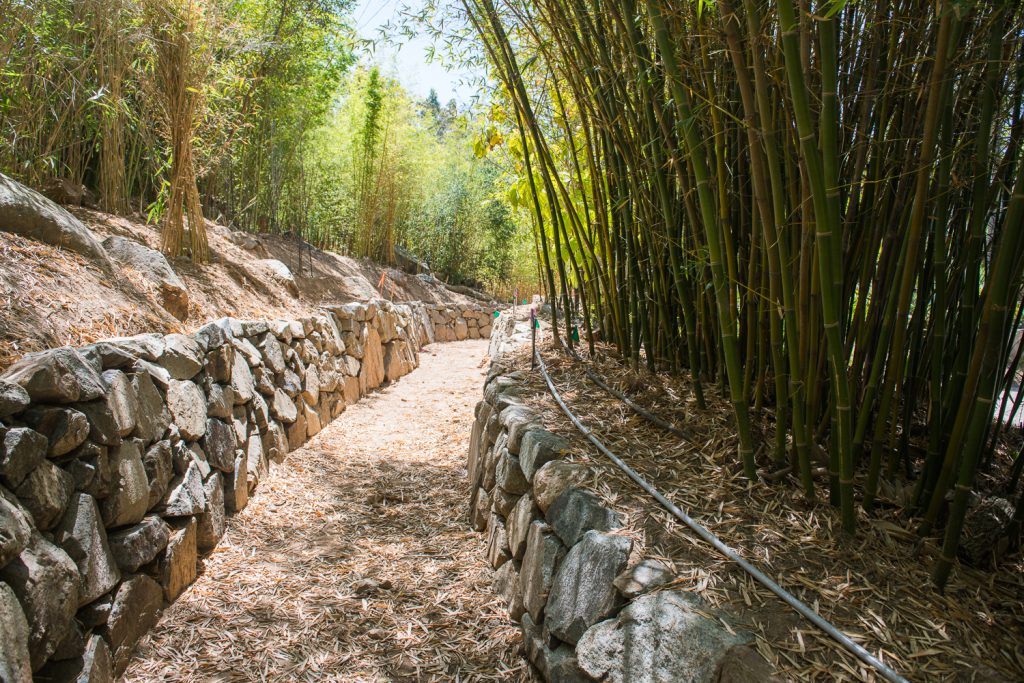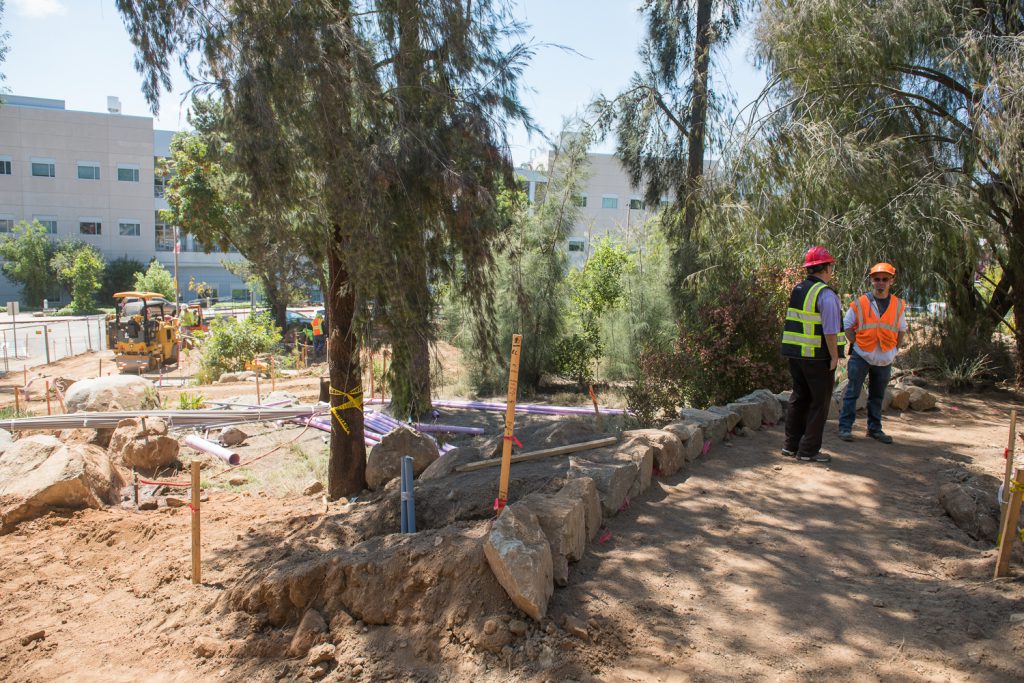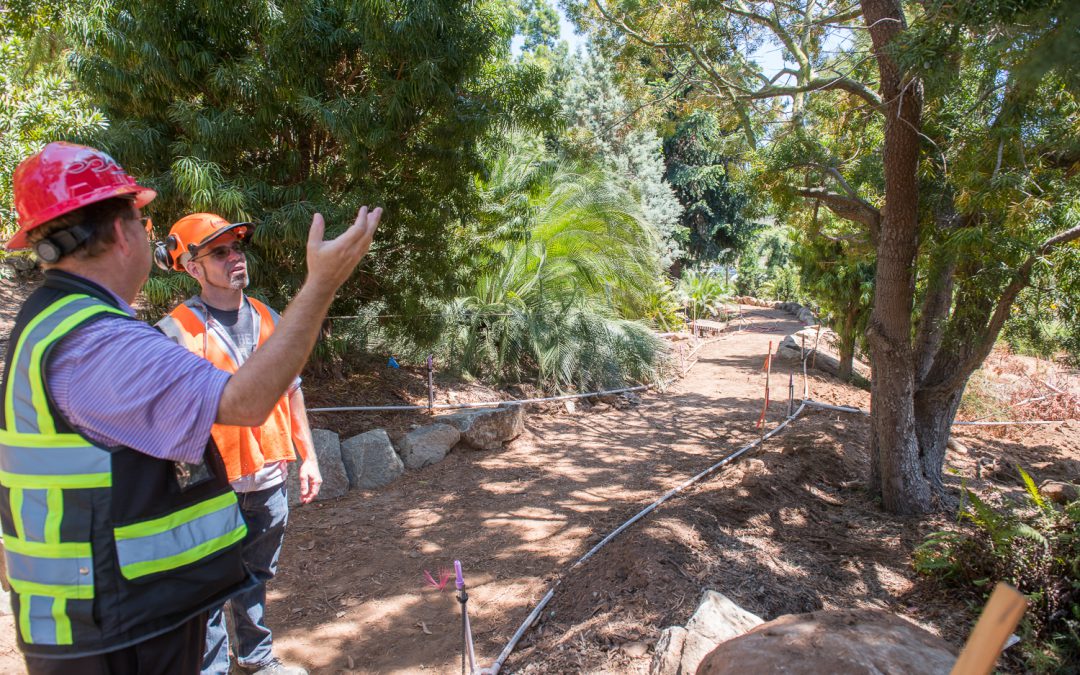Pictured above: Palomar College Manager of Construction and Facilities Planning Dennis Astl, left, and Grounds Services Supervisor Tony Rangel discuss one of the trees near the newly refurbished trail in the college’s arboretum.
A long-awaited set of improvements to the 10-acre Edwin & Frances Hunter Arboretum at Palomar College are nearly complete, as crews remake a space long known for its biological diversity.
SAN MARCOS — It has always been a haven for nature lovers, but since its founding in 1970, the Edwin & Frances Hunter Arboretum existed as a loose patchwork of hiking trails, irrigated with imported domestic water.
When the arboretum reopens this fall after six months of renovations, it will feature ADA-compliant pathways and a new groundwater well pumping out up to 40 gallons per minute and reducing the college’s overall demand for imported water by as much as one-third every year.
The arboretum is named for North County business leaders Edwin and Frances Hunter, long-time supporters of the college. In 2015, the Hunter family and Hunter Industries established a sizable endowment to ensure the maintenance of the arboretum with a $500,000 donation to the Palomar College Foundation.
The capital improvements currently underway were funded by Prop. M, the $694 million bond measure approved by voters in 2006.
Since Palomar College officials broke ground on the project in March, a network of trails has taken shape, buttressed by natural rock retaining walls and traversing the lower portion of the arboretum where most of the important specimens are located, according to Palomar’s Grounds Services Supervisor, Tony Rangel.

Natural rock, sourced on-site, was used to build the many retaining walls and trail boundaries now featured in the arboretum.
“It’s a place for people to go and relax and be in nature,” Rangel said. “But more importantly, it’s for species conservation and education—to educate the public about the different species that can grow here, and to educate the public on the status of these species in the wild.”
After the current improvements, he said, the trees and plants that college staff and volunteers have carefully cultivated for decades will be better showcased than they were in the past.
A Grand Opening ceremony will be held this fall to open the improved arboretum to the public.
Dennis Astl, the Manager of Construction and Facilities Planning at Palomar, said the greatest challenge in planning the improvements was routing the trails in order to avoid taking out any trees, while meeting the grade and width requirements of the Americans with Disabilities Act.
“The original design had a tremendous amount of concrete stairs and retaining walls to get it done,” said Astl. “We were able to play around with the trails and … they are now built with natural rock retaining walls.”
That rock, it turns out, has all been sourced on-site, and it is found throughout the lower portion of the arboretum, supporting switchbacks and creating the visual boundaries of the path as it meanders through the trees.
“It’s almost hard to describe how different it will be for visitors,” Astl said. “Before, it was kind of like, ‘I think I’m on a path, but I’m not quite sure.’ Now, you know when you’re on the path.”
As the project progressed in late June, crews were pouring concrete, moving dirt, installing new irrigation lines and a variety of other jobs to completely refashion the front of the arboretum.
Standing by silently, and for the most part undisturbed, were the 600-plus species of trees and plants that call the arboretum home.

Leading a casual tour of the arboretum under construction, Rangel pointed out various trees of interest, from a ginkgo biloba tree right next to the path to a new palm tree grove along the northern edge of the preserve to an area Rangel calls “Jurassic Park” because of the primitive trees growing there—former “dinosaur food,” in his parlance.
“Here are three different species of ancient conifers native to California, and they’re all on the endangered list,” Rangel said, traversing one of the newly minted paths through the shade.
Nearby, he pointed out a Queensland kauri pine that has grown 30 feet since it was planted in 2007, and explained that this variety was used to make masts for oceangoing ships in centuries past; this one will eventually tower over the arboretum, he said.
Rangel said all of the big trees have been surveyed and documented, and that the goal is to provide an interactive map online so that visitors can use their smartphones to read more about the specimens as they walk through the arboretum.
After the project’s general contractor, LB Civil Construction, finishes the physical improvements in August, Rangel’s team will go to work “back-planting,” or filling in all of the newly available space near the trails with plants grown in Palomar’s own nursery and greenhouse.
In short, what was already a beautiful and serene nature preserve will soon be visitor-friendly and accessible to anyone who wants to enjoy the wildlife.

